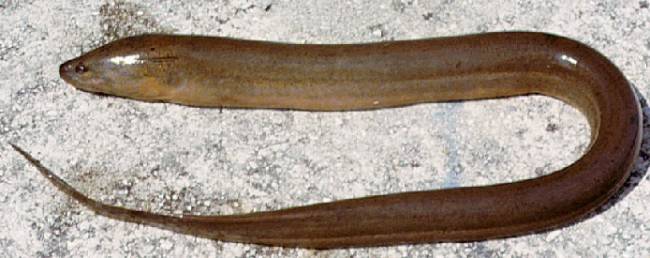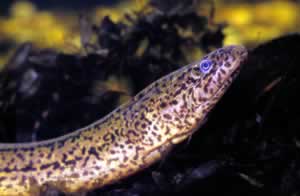
Scientific Name: Monopterus Albus
Classification:
Phylum or Division: Chordata
Class: Actinopterygii
Order: Synbranchiformes
Family: Synbranchidae
Subfamily: Neopterygii
Identification:
The Asian Swamp Eel has an elongated, snake-like body, with a blunt,
rounded nose. It doesn't appear to have any fins, and it's slippery skin
is darker green or brown on the top, growing lighter towards the eel's
underbelly. It has rows of very mall teeth that appear more like bristles
(villiform) and smallish dark eyes. It has one, V-shaped gill opening on
it's underside, just below the head. They can grow to to a lengh of one
meter, which is about three feet long, and weigh up to one pound.
Original Distribution: It is native to regions in eastern and southern Asia, and also possibly indigenous to Australia. It can be found in muddy ponds, canals, medium to large rivers, rice fields and swamps.
Current Distribution: The Asian Swamp Eel was first introduced in the U.S. in Hawaii, some time around 1900. In 1994, eels were found in northeastern Georgia near the Chattahoochee river, and in 1997, populations were documented in canals in northern Miami, and in drainage ponds near Tampa bay. They have been spotted within 1 kilometer of the Everglades National Park, but have not yet been found inside the park.
Site and Date of Introduction: In southern Florida and northeastern Georgia, early to Mid 1990s. In Hawaii, around 1900.
Mode(s) of Introduction: In Florida and Georgia, introduction is likely due to an aquarium release or a fish farm escape or release. It is believed that eels were originally brought to Hawaii by Asian immigrants as a food fish, and purposely released into the wild.
Reason(s) Why it has Become Established: The Asian swamp eel is is a generalized predator and has many highly adaptive traits that make it a true survivor. It has no known natural predators in the U.S., and seems to feed on a variety of water animals. Remarkably, the eel can also breath air, often nosing to the surface to get a breath. With the help of specialized gills, this air breather can travel over land when it needs to find a new home (for more food, or to breed), live in brackish water that's partly salty, or even in anoxic conditions in dried ponds or swamps. It is able to survive in colder climates as well, even through heavy freezes and ice cover. The eel is able to feed both in the water and out, and, like a few other aquatic species, it is transsexual. In some populations, young are hatched as females, mature as females, then pass through a nonfunctional stage for about a year that leads to their transforming into a larger males. These males aggressively guard eggs from predators, making their reproductive success all the more likely. Other forms of sexual transformation have been documented as well. The asian eel eats voraciously, and seems to like tadpoles, crayfish, shrimp, worms, and fish of varying sizes. While they can seem to feed without end (in captivity, researchers have been impressed with their consuming "minnow after minnow" with no limit to their appetite) they are also able to survive months without a food source if necessary.
Ecological Role: The Asian Eel is a generalized predator (carnivore) that consumes animals such as crayfish, tadpoles, small fish and worms (They can eat some larger pray as well, by grabbing them with their mouths, and spinning until they are torn in half). They are likely to affect the population size of their prey, as well as the availability of food sources for larger fish, turtles, frogs and wading birds. They may also play a role in altering the habitat beneath ponds and marshy regions where they burrow nests to wait out dry seasons.
Benefit(s): In Asia, they are considered a food fish, and a delicacy. They are also found in markets as food in the United States, as well as in pet supply stores, although they are not as well known.
Threat(s): While it is really too early to tell, most researchers suspect that the threat from this species is very high, considering that facts that they have no known predator at this time, have sophisticated adaptive skills, and insatiable eating habits that could affect the food source native fish species. Many fear that the eel may enter the Florida Everglades and cause loss of native species there. According to some sources, declines in native centrarchids (like the blue gill) from other areas of the United States have been attributed to the Asian Eel.
Control Level
Diagnosis: While I could find no references to problems with
introduction, or of existing populations, in Hawaii, and subsequently no
mention of control efforts, these species are considered a high priority
for control in Florida and Georgia. This is because of strengths as a competitor,
and because they can easily move through water systems to populate a much
large area in the mainland United States.

Control Method:
No method of containment has been determined. State, university and non-profit
agencies in Florida and Georgia have researched methods of control, but
have yet to be successful. In tests, poisoning the water with a chemical
that makes it impossible for fish to use oxygen (rotenone), is not effective
on eels. They simply lift their heads out of the water and breathe air.
Another known method for aquatic pests - using Dynamite - is similarly
ill suited for controlling eels. They do not have a large air bladder which
would make a fish susceptible to concussion blasts; and also, they simply
retreat into their burrows. Beyond these problems, the use of such crude
methods in such ecologically protected regions as the Everglades, is unlikely
to happen. As for research, and monitoring the species, the only
way of catching or detecting these secretive animals, who mostly feed and
move about at night, is by using a specially equipped boat that sends an
electric shock through the water, temporarily destabilizing nearby animals.
These "electro-fishing" devices are helping advance the research and data
about the species, and with it, the concern is growing.